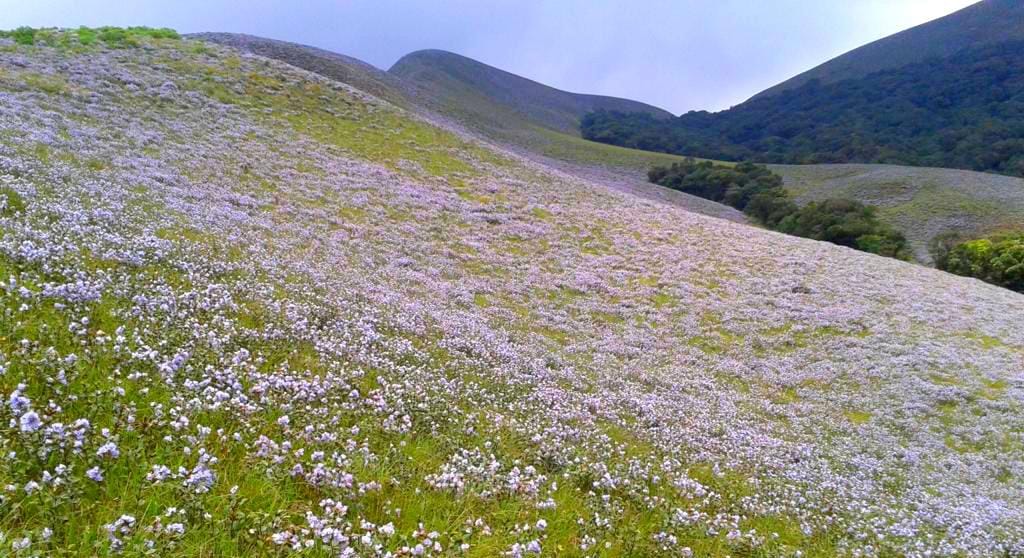A once-in-12-years phenomenon, the blooming Neelakurinjis are attracting hordes of visitors from within and outside Kerala.

Blooming neelakurinjis are a visual treat in Kerala's Idukki. (Lekha Biju)
When two of her sons carried 87-year-old Elikutty Paul on their shoulders while traversing the steep hills on the way to Kallippara in the high-range areas of Kerala’s Idukki district on 14 October, it fulfilled a long cherished dream of the octogenarian homemaker.
She wanted to witness the once-in-twelve-year phenomenon that unfolds in some tracts of Western Ghats: The blooming of the neelakurinji plants, known scientifically as Strobilanthes kunthiana.
Elikutty belongs to Muttuchira in the downhill Kottayam district, but age-related ailments failed to deter her from the arduous journey to the hills and to watch the rare spectacle.
Her sons Rojan and Sathyan, travel aficionados in their own capacity, said it was their responsibility to make her dream a reality. With their families accompanying them, the sons trekked through the rugged terrain carrying their mother.
“It was indeed a great experience. I have heard about neelakurinji since childhood, but was never able to see them. My sons made it possible this time, and the spectacle was beyond words. I felt enthralled,” Elikutty told South First when contacted over the phone.
Throngs of travel enthusiasts from Tamil Nadu, Karnataka and Kerala have been reaching Kallippara, located between the famous hill stations Munnar and Thekkady, daily for the last two weeks as the rare blue spectacle has now spread in the vast expanses grasslands there.
Though the neelakurinji has also bloomed in Ooty in Tamil Nadu and Chikmagalur in Karnataka this time, tourists prefer Kallippara as it is strategically positioned between the hill station of Kodaikanal in Tamil Nadu, and Munnar and Thekkady in Kerala.
People can easily reach the place via Madurai or Kochi.
Neelakurinji has different varieties, which are endemic to the Western Ghats. The shrub grows only in very few shola forests of the region’s ecosystem. In Tamil and Malayalam, neela is blue.
The Nilgiri hills of Tamil Nadu is said to have got its name from the species: The blue mountains.
Kallippara is located in Santhanpara gram panchayat and can be accessed by the Munnar-Kumily state highway. Visitors are permitted to the bloomed hills and valleys until 4.30 pm each day, and no plastic products are permitted.
In the face of a massive rush of visitors, strict security measures have been undertaken in the region to avoid damage to the plants and flowers.
A stiff fine awaits those who pluck or destroy the flowers or plants.
Other than Kallippara, neelakurinji blooms can be found in adjoining tourist locations like Kovilur, Kadavari, Rajamala, and Eravikulam, a national park devoted to protecting the endangered Nilgiri Tahr.
Botanists confirm that there are more than 40 different varieties of neelakurinji and they are all indigenous to the Western Ghats’ shola forests. Across the ghats, there are about 30 locations where the plant grows.
According to botanist and environmental activist E Kunhikrishnan, six plant varieties are now blooming in Kallippara and its surroundings.
The majority of the blooms belong to the Strobilanthes kunthiana family. Strobilanthes anamallaica, Strobilanthes heyneanus, Strobilanthes pulnyensis, and Strobilanthes neoasper are the other varieties blooming in the region now.
“The plants have bloomed in a 200-acre area in Kallippara now. This is the largest among the bloomed areas, and this time the local community is vigilant in protecting them,” he told South First.
According to VS Aswathi, a member of the Idukki District Biodiversity Board, the plants have now bloomed on revenue land, and so safe protection is a challenge to the board as well as the local gram panchayat.
“We have sought government intervention and funds to keep the area a permanent neelakurinji garden,” she said.
“The green patches of the area have turned purple-blue now. The excitement is quite unimaginable. It’s a rare fortune only very few can enjoy,” said Sunil K Faizal, a bank employee from Wayanad who travelled for about nine hours by bus to watch the rare phenomenon.
The remarkable blooming of #Neelakurinji flowers in #Chikmagalur, Karnataka. pic.twitter.com/U6DguYpZZZ
— P C Mohan (@PCMohanMP) October 15, 2022

Apr 29, 2024

Apr 29, 2024

Apr 29, 2024

Apr 29, 2024

Apr 28, 2024

Apr 28, 2024